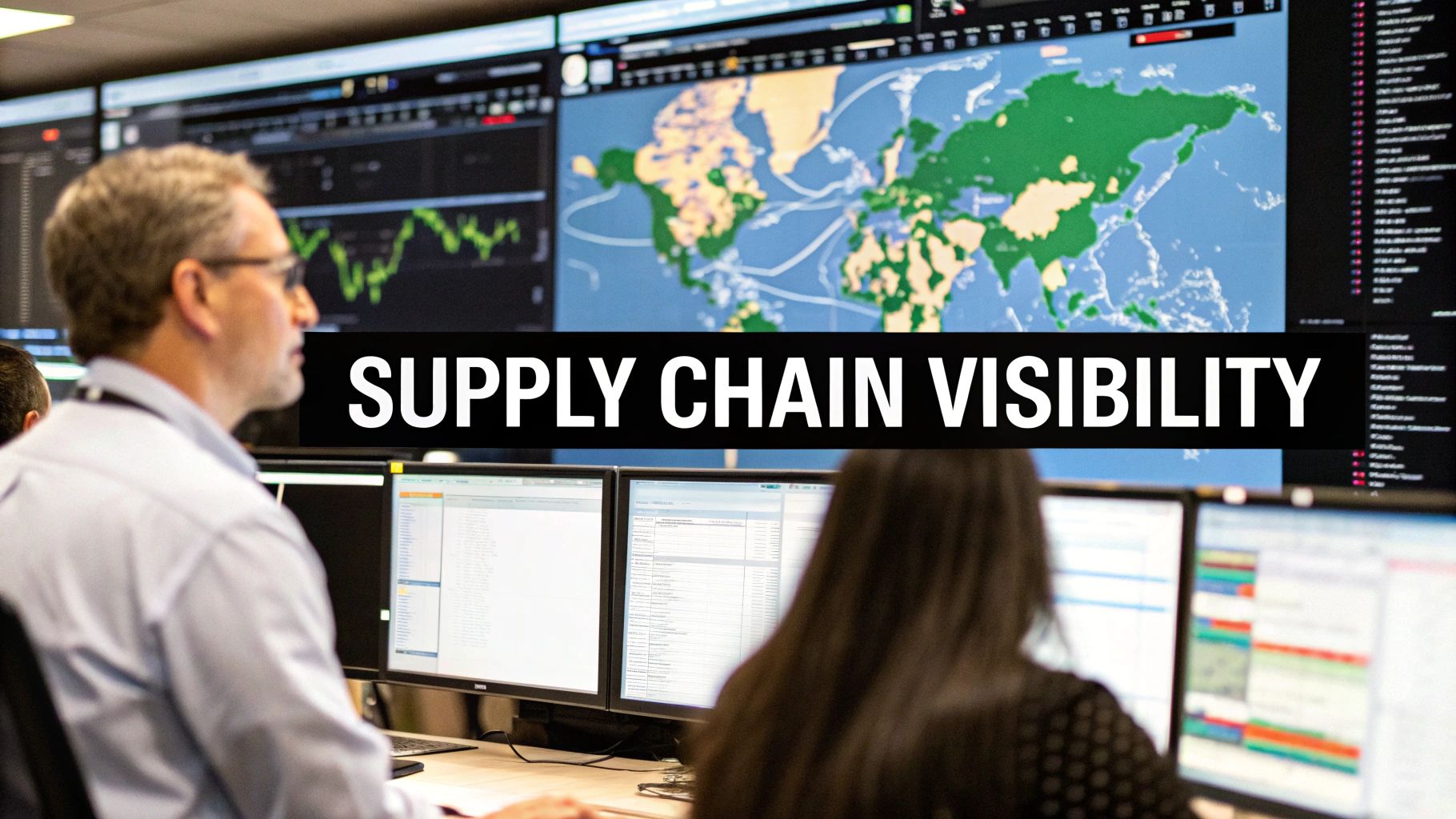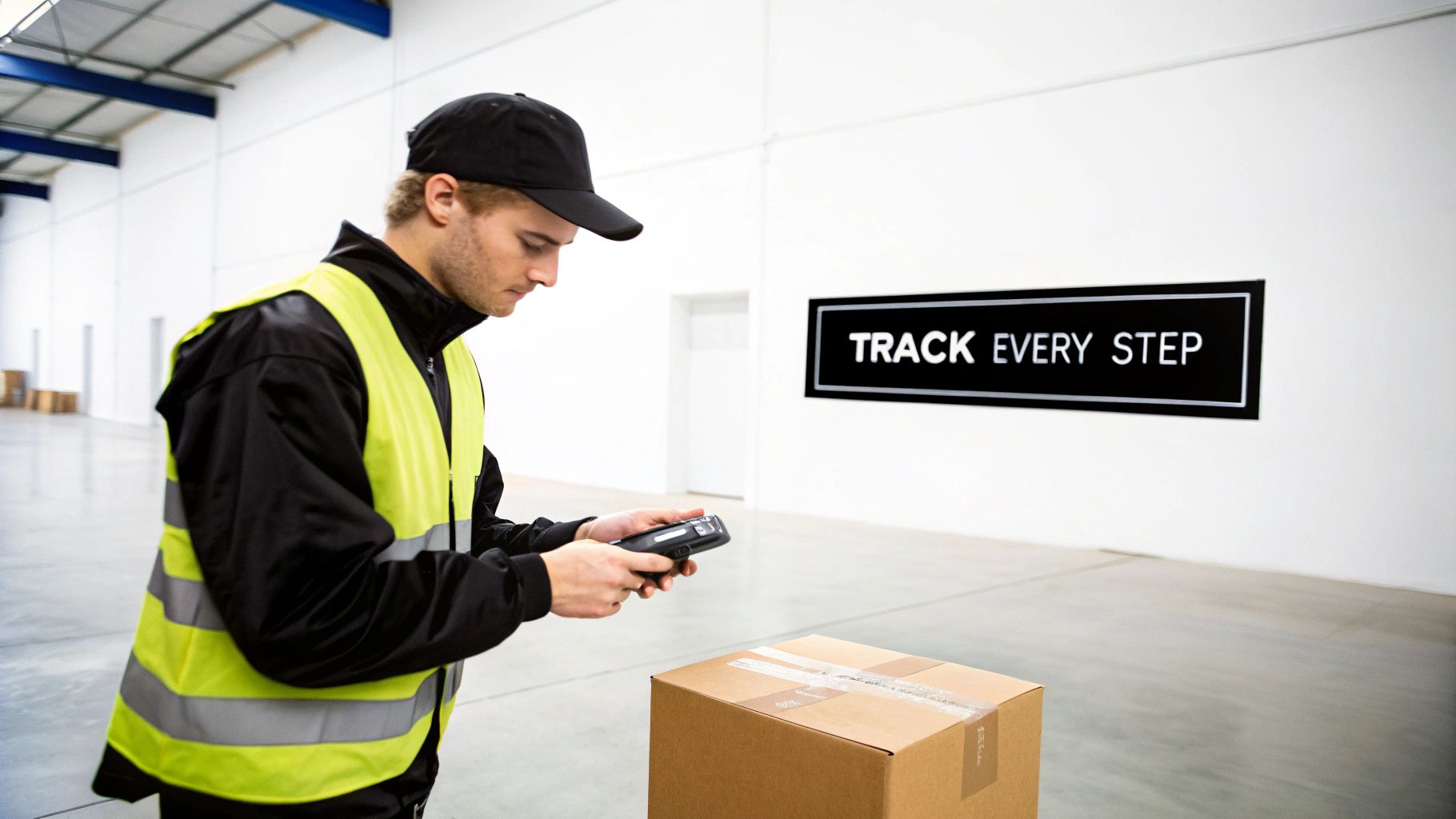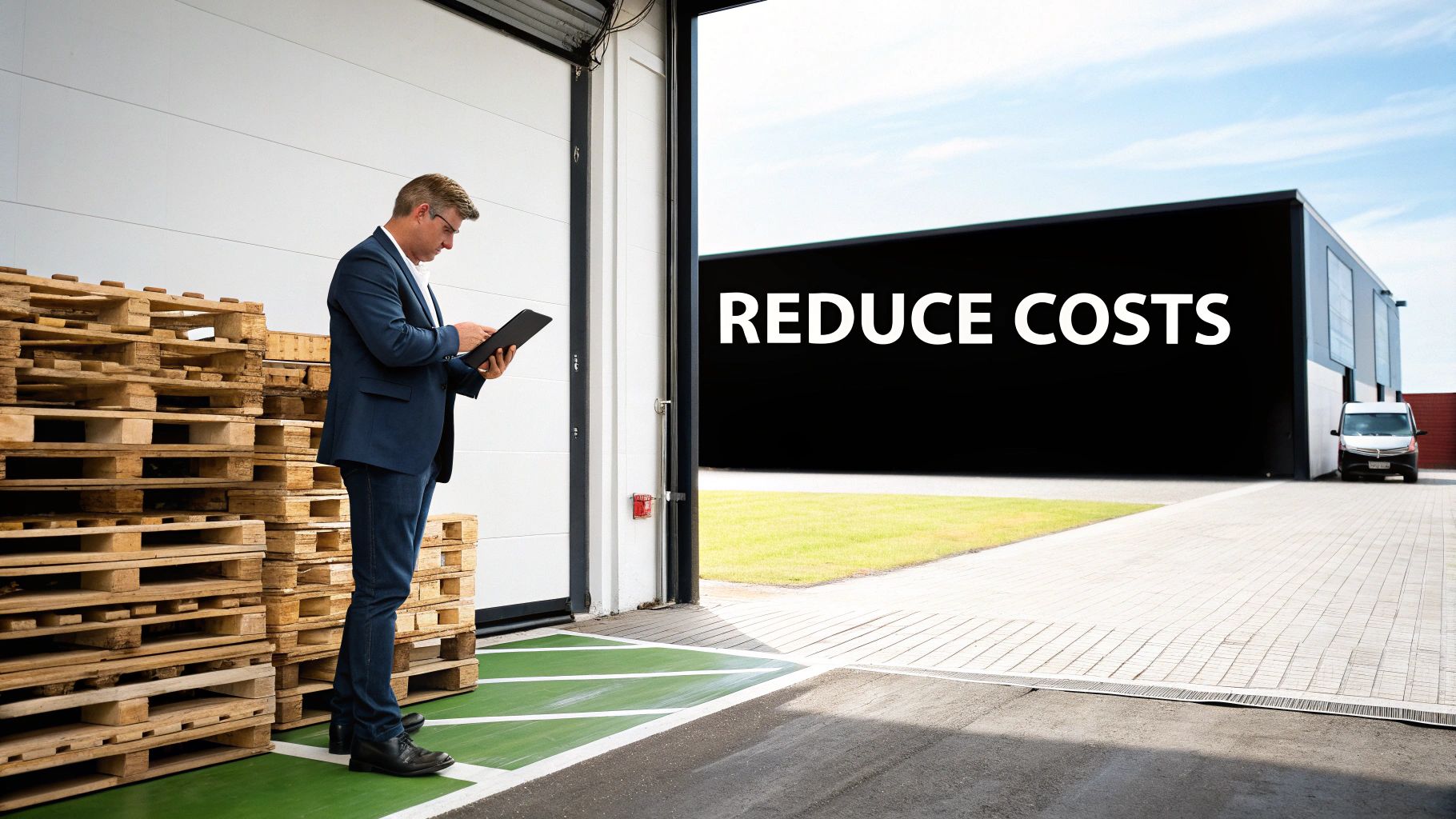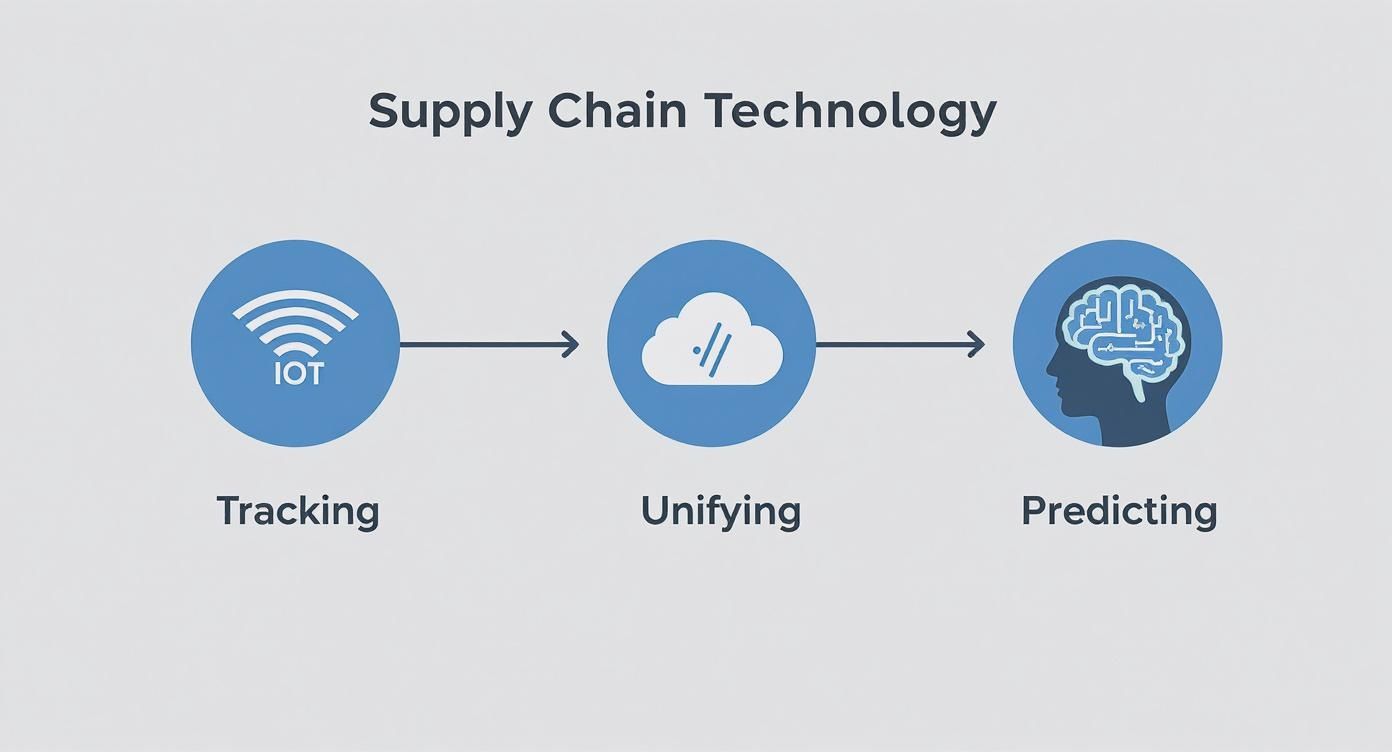Achieve complete supply chain visibility. This guide explains what it is, why it matters, and how to implement it to cut costs and boost efficiency.

Let’s cut through the jargon. At its heart, supply chain visibility is about knowing exactly where your stuff is at any given moment. It’s the ability to track products, parts, and raw materials as they travel from your supplier all the way to your customer's doorstep.
It's about having a clear, real-time picture of your entire logistics network, so there are no more guessing games.

Ever ordered a pizza online and watched the little icon move from "prepping" to "baking" to "out for delivery"? That’s the core idea of supply chain visibility, just scaled up for a global, multimillion-dollar operation. It's that same end-to-end clarity.
But it’s so much more than just watching a dot on a map. True visibility means you have instant access to accurate data from every single link in your chain. From the moment raw materials leave the supplier, through the factory floor, into the warehouse, and onto the final truck for delivery—you see it all. This comprehensive view shifts logistics from a reactive, fire-fighting mode to a proactive, data-informed strategy.
Whether you're moving a full truckload (FTL) of goods or a smaller less-than-truckload (LTL) shipment, knowing its precise status is crucial. Without that insight, you’re flying blind.
Not long ago, a quick phone call to a carrier for an update was standard practice. Those days are over. Today’s supply chains are sprawling, complex webs that are constantly under pressure from disruptions. This complexity has turned visibility from a luxury into a business necessity.
The numbers don't lie. Looking ahead to 2025, a staggering 57% of supply chain professionals say a lack of visibility is their single biggest operational challenge. On top of that, 56% of companies are feeling the direct impact of geopolitical issues, making real-time monitoring essential for navigating the chaos. You can dive deeper into these supply chain statistics to see just how much the landscape has changed.
This is where visibility really proves its worth. It gives you the power to make quick, smart decisions when—not if—the unexpected happens.
Getting a clear picture isn't about one magic piece of software. It’s about weaving together data, technology, and processes to understand a few key things:
The ultimate goal is to build a "single source of truth." This is a shared, synchronized platform where everyone—suppliers, manufacturers, carriers, and even customers—sees the same information at the same time. This shared view cuts out confusion and fosters real collaboration.
When you achieve this level of clarity, you can spot potential delays before they become problems, reroute shipments around a storm or a traffic jam, and give customers the accurate updates they’ve come to expect. It’s about finally taking control of your logistics network instead of letting it control you.

Getting a clear, real-time look into your supply chain isn't just a logistical tweak—it's a serious business strategy that pays real dividends. The benefits of supply chain visibility touch every corner of your company, directly improving how you operate, how your customers see you, and ultimately, your bottom line.
When you can track every shipment, you stop reacting to problems and start proactively managing your operations. It’s a fundamental shift that unlocks some pretty powerful advantages.
One of the first things you'll notice is a sharp drop in unnecessary spending. When you're operating in the dark, you naturally overspend to cover your bases.
Take expedited freight, for instance. If you're not sure whether a critical full truckload (FTL) or less than truckload (LTL) shipment will show up on time, you'll probably pay a premium for rush shipping just in case. Real-time tracking makes that guesswork obsolete. You know exactly where your freight is, which lets you plan with confidence and ditch those costly emergency measures.
This clarity bleeds over into inventory management, too. Poor visibility forces many companies to hold mountains of "safety stock" as a buffer against delays, tying up huge amounts of cash.
By seeing your entire inventory—what’s in the warehouse and what’s on the road—you can run much leaner. It’s the difference between stockpiling for a storm you can't see coming and simply preparing for rain that's clearly on the radar.
In today's world, customer experience is king. Vague delivery windows and being clueless about delays just don't cut it anymore. Great supply chain visibility gives you the power to provide the transparency your customers crave.
Imagine telling a customer precisely when their order will arrive, with an ETA that updates dynamically. Better yet, imagine proactively alerting them to a potential delay and offering a solution before they even realize there’s a problem. That’s the kind of service that builds incredible trust and loyalty.
This kind of communication starts with better internal data. A recent survey found that 45% of mid-market manufacturers are actively working on improving their end-to-end visibility. It helps them plan inventory better and slash those expedited freight costs, which translates directly into a more reliable experience for their customers. To dig deeper, you can read more about why visibility is so critical in 2025.
Modern supply chains are fragile, facing everything from port congestion and labor strikes to unexpected supplier hiccups. Visibility acts as your early warning system, buying you precious time to react effectively.
For example, if a key supplier's shipment gets held up, a visible supply chain lets you spot the delay instantly. This gives you a crucial head start to:
Without that insight, a small delay can quickly snowball into a full-blown crisis, causing production shutdowns and broken promises. With visibility, you can contain the problem and keep the wheels turning.
If getting a clear view of your supply chain was easy, everyone would have it mastered by now. The truth is, most companies are still bumping into major hurdles that create expensive and frustrating blind spots in their operations.
Let's be honest, figuring out what those roadblocks are is the first real step to tearing them down.
So often, the journey toward a transparent supply chain starts right at home, by confronting our own internal mess. Many organizations are split into departments that barely talk to each other, let alone share data. Each one has its own systems, its own processes, and its own version of the truth.
This creates a frustrating landscape of "data silos." Think about it: your accounting team has the payment info, the warehouse has the inventory levels in their WMS, and your carrier's website has the tracking status. When those systems don't connect, you're left trying to piece together a puzzle with half the pieces missing. You simply can't get a single, coherent story of an order’s life from start to finish.
Another huge barrier is clinging to old technology and manual workflows. It’s surprising how many businesses still run their logistics on a patchwork of spreadsheets, endless email chains, and constant phone calls. These tools might feel familiar, but they are incredibly reactive and wide open to human error.
Let’s face it, manual processes just can't keep pace with the modern world. You're always playing catch-up, working with information that's already stale. This makes it nearly impossible to make smart, proactive decisions. This is exactly why so many companies get caught flat-footed during a crisis. For a deeper dive on this, check out our guide to effective supply chain disruption management.
Today’s supply chains aren't a straight line from A to B. They're complex, sprawling networks with multiple layers. You have your direct suppliers (Tier 1), but you also have their suppliers (Tier 2), and even the suppliers of those suppliers (Tier 3). Visibility tends to completely vanish the deeper you go.
You might have a fantastic data feed from your main parts manufacturer, but do you have any idea where they get their raw materials? A problem at a Tier 2 or Tier 3 supplier can send shockwaves all the way up to your production line, yet most companies are flying blind to these downstream risks.
The numbers really drive this point home. By 2025, a tiny 13% of businesses expect to have full visibility across their entire sourcing network. While 54% feel they know more than half of their suppliers, a whopping 33% admit to knowing less than half—or can’t even begin to guess.
This lack of deep-tier insight is a massive vulnerability. It means you could be completely unaware of risks bubbling up from geopolitical conflicts, labor disputes, or environmental issues happening several steps removed from your direct partners. You can explore more on these global supply chain visibility trends and what they mean for businesses.
Tackling these challenges—from breaking down your own internal silos to peering deep into your network—is the real work of building a visibility strategy. It’s about committing to connecting systems, adopting the right technology, and building real, collaborative partnerships with everyone in your chain, from the farm to the final doorstep.
Getting true supply chain visibility isn't some kind of magic trick—it’s all about having the right tech working in harmony. These tools are what turn a messy collection of data points into a clear, actionable picture of your entire logistics network.
Think of it this way: each piece of technology is designed to solve a very specific problem. From tiny sensors on a pallet to powerful cloud software, every component has a job to do, all aimed at one thing—getting rid of blind spots and putting you back in control.
The most basic layer of visibility starts with a simple question: where are my goods, and how are they doing right now? This is where the Internet of Things (IoT) comes in. IoT devices are basically small, smart sensors that act as digital guardians for your freight.
And we're not just talking about simple GPS trackers anymore. Today's IoT sensors can monitor a huge range of conditions, which is a lifesaver for sensitive shipments.
By attaching these little gadgets to your assets, pallets, or even individual boxes, you get a constant stream of live data. Suddenly, every shipment becomes a smart, trackable unit.
To make sense of all this technology, it helps to see how each piece fits into the puzzle. The table below breaks down the most common tools, what they do, and the problems they solve.
Each of these technologies builds on the others, creating a complete visibility solution that is far more powerful than the sum of its parts.
All that fantastic data from IoT sensors, carrier updates, and warehouse systems needs a place to go where you can actually make sense of it. This is the job of cloud-based platforms and Transportation Management Systems (TMS). They act as the central command center for your entire supply chain.
These platforms are specifically designed to demolish the data silos we talked about earlier. They pull information from all your partners—suppliers, manufacturers, carriers, and 3PLs—into a single, unified view. Instead of logging into a dozen different carrier portals, you get one dashboard that tells you the whole story. You can learn more about how this centralization works by exploring the benefits of a Transportation Management System.
A cloud platform acts as the "single source of truth." It ensures everyone involved in a shipment, from the warehouse manager to the end customer, is looking at the same real-time information, which drastically reduces confusion and errors.
Once you have all your data neatly collected in one place, the real magic can happen. Artificial Intelligence (AI) and Machine Learning (ML) step in to act as a smart co-pilot, sifting through massive datasets to spot patterns and make predictions that a human simply couldn't.
AI doesn't just tell you where your shipment is right now; it tells you where it’s going to be and what roadblocks it might hit along the way.
This predictive power is what shifts you from just reacting to problems to actively managing your supply chain with genuine foresight. And it's not just about tracking; technologies like 3D printing are also changing the game for inventory and production. For more on that, check out this great resource: Transforming Manufacturing: The Impact of 3D Printing on Production and Supply Chain.
When you put them all together, these technologies create a powerful ecosystem. IoT devices gather the raw facts, cloud platforms organize them, and AI gives you the intelligence to act on them. That’s how you build the end-to-end visibility you need to win.
Knowing you need better supply chain visibility is one thing; actually making it happen is a whole different ball game. The good news? You don’t have to tear down your entire operation and start from scratch. A smart, step-by-step approach gets you there without the chaos and makes sure your efforts pay off.
Think of this five-step plan as your roadmap. It’s designed to help you get from idea to execution, building a stronger, more transparent, and seriously efficient supply chain along the way.
You can't fix what you can't see. The very first thing to do is draw a detailed map of your supply chain as it exists right now. And I don't just mean a list of your direct suppliers and shipping companies. You need to trace the entire journey.
Follow your products from the raw material source all the way to the customer's front door. Identify every partner, every handoff, and every point where information just seems to disappear into a black hole. This audit is your treasure map—it will point you directly to your biggest weaknesses and give you a clear place to start.
Once you have your map, you can set real, measurable goals. Fuzzy targets like "improve visibility" are a recipe for going nowhere. You need to get specific and tie your goals directly to the pain points you just uncovered.
What do you really want to accomplish?
When you define clear KPIs right out of the gate, you have a solid benchmark. It's how you'll measure success and prove to your team (and your boss) that these changes are making a real difference.
Technology is the engine that brings modern supply chain visibility to life, but picking the right tools is everything. You don't need some massive, over-the-top enterprise system if you're just getting your feet wet. The key is finding partners and platforms that actually fit your business, your budget, and the goals you just set.
Start by focusing on solutions that solve your biggest headache first. For a lot of businesses, that means partnering with a great freight provider that offers real-time tracking for both their FTL and LTL shipments. The right tech should make your life simpler, not add another confusing dashboard to your plate.
A fancy visibility platform is useless without good data feeding it. This step is all about breaking down the communication silos between you, your suppliers, your manufacturers, and your carriers. It’s about building a culture where sharing information is the default.
Work with your partners to get the data flowing smoothly. Sometimes this means integrating their systems directly with yours, but other times it’s as simple as setting up clear rules for how and when they share shipment status updates.
The goal here is to create a single source of truth. A shared, real-time view where everyone involved in a shipment—from the warehouse floor to the C-suite—is looking at the exact same information. This kind of alignment is what wipes out confusion, slashes errors, and builds genuinely strong relationships across your network.
Finally, please don't try to boil the ocean. Instead of trying to change everything at once, start small with a focused pilot project. Pick one shipping lane, one product line, or one key supplier to test out your new visibility strategy.
This lets you work out the kinks in a low-stakes environment, score some early wins, and build momentum. Once you’ve proven the concept and can show a clear return on investment, you can confidently start rolling out the solution to the rest of your supply chain. It's a methodical approach that minimizes risk and dramatically increases your chances of long-term success.
This visual below breaks down the core technological flow: tracking the data, bringing it all together in the cloud, and then using that intelligence to see what's coming next.

This process shows how raw tracking data gets turned into powerful business insights, taking you from just reacting to problems to actively predicting them.
https://www.youtube.com/embed/witWunLCEdI
You’ve invested time and resources into boosting your supply chain visibility. That’s a huge step. But the big question from the C-suite is always going to be, "What's the ROI?" To answer that, you need to show them the numbers.
It's tempting to just point to on-time delivery rates, but that's only a tiny piece of the puzzle. The real proof is in the Key Performance Indicators (KPIs) that connect better visibility directly to a healthier bottom line, happier customers, and a smoother operation.
Think of these KPIs as your supply chain's report card. They tell you the story of what’s happening from the moment an order is placed until it reaches its final destination. Tracking them is how you prove your visibility efforts are paying off.
A few crucial ones to watch are:
Tracking these numbers gives you a clear, honest look at how your operations are performing. For a deeper dive, check out our guide to key logistics performance metrics.
If there's one metric that sums it all up, it's the Perfect Order Rate. This isn't just about being on time. It measures the percentage of orders that are delivered flawlessly—no damage, correct items, accurate paperwork, and on schedule. It's the ultimate benchmark for customer satisfaction.
A high Perfect Order Rate tells you that your entire system is firing on all cylinders. It’s tangible proof that your visibility strategy is working, seamlessly coordinating every moving part of the journey for both your FTL and LTL shipments.
When you see this rate dip, you know exactly where to look. Maybe a specific carrier is consistently having issues, or there’s a recurring problem in the warehouse. Visibility allows you to pinpoint the root cause and fix it fast, before it snowballs.
To really get a handle on performance, a good dashboard is essential. Here are some key metrics to track that show the true impact of your visibility strategy.
Consistently monitoring these KPIs gives you the data-driven insights you need to not only justify your investment but also to continuously fine-tune your operations for even better results.
Ready to improve your numbers? Getting a quote can show you how reliable carriers and better visibility make a world of difference.
Jumping into a new way of managing your logistics is bound to bring up a few questions. Let's tackle some of the most common ones we hear about supply chain visibility so you can move forward feeling confident.
That's the million-dollar question, isn't it? The truth is, the cost can be all over the map, from affordable monthly subscriptions to massive enterprise-level systems. The key is not to bite off more than you can chew right at the start.
Honestly, many businesses see a fantastic return just by using platforms that give them better real-time tracking on their LTL (less than truckload) and FTL (full truckload) freight. The best solution is the one that fixes your biggest headaches today but has enough room to grow with you tomorrow.
Absolutely. This isn't just a game for the big players anymore. Thanks to cloud-based platforms and technology becoming more affordable, small and medium-sized businesses can get their hands on some seriously powerful tools without a huge upfront investment.
The smart move is to focus on what will give you the most bang for your buck first. Start with tracking your shipments better and team up with logistics partners who already offer solid visibility tools. You'll get immediate wins without having to completely overhaul your own operations.
This is a great question, and it's one we get all the time because the two terms get tangled up. They're related, but they do different jobs.
Here's a simple way to think about it: visibility is your live GPS for the present and near future, while traceability is the complete, permanent travel log of the past. You really need both to build a supply chain that's truly transparent and can handle whatever gets thrown at it.
Getting these basics down will help you make much smarter decisions about your freight and overall strategy.